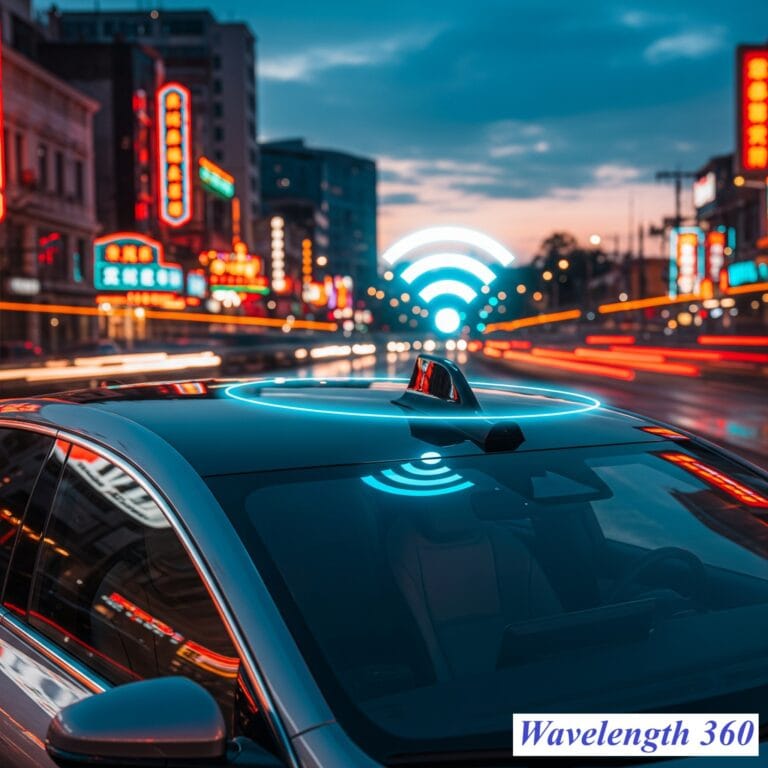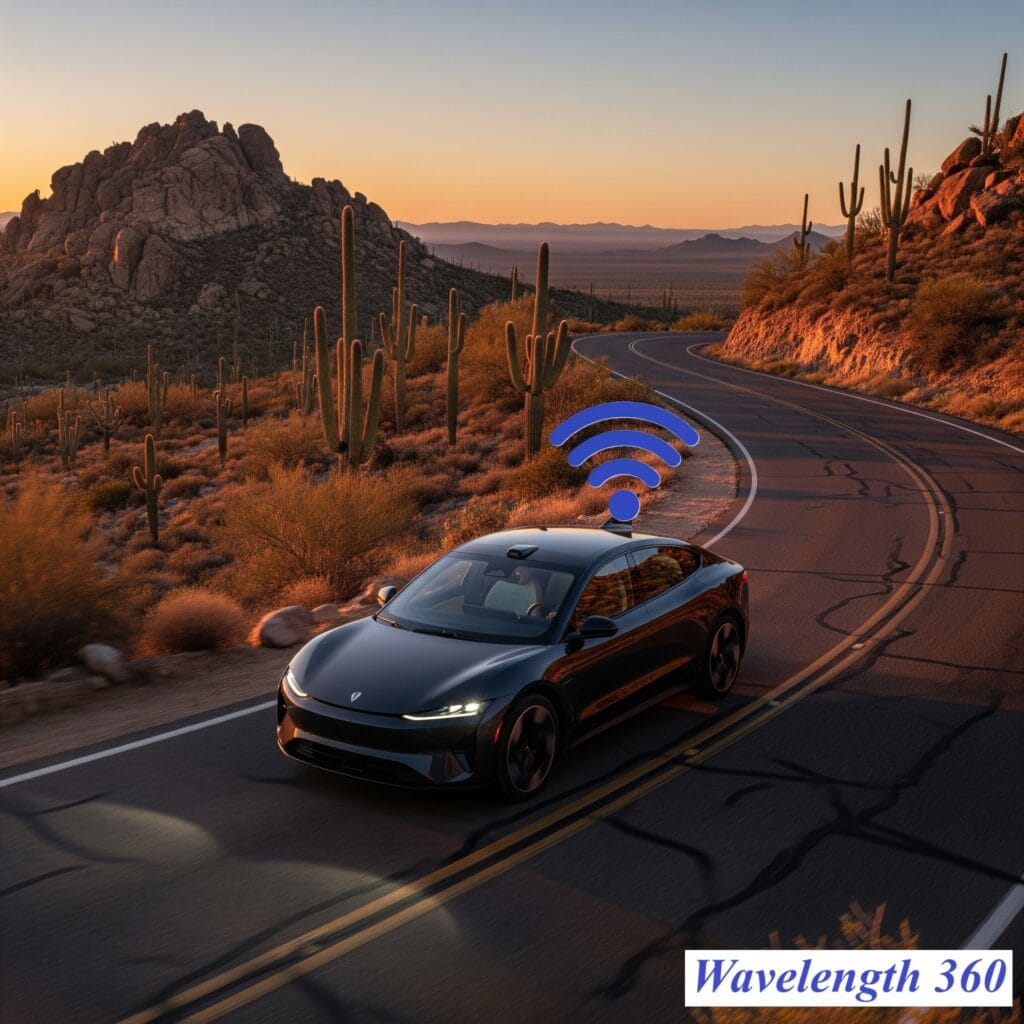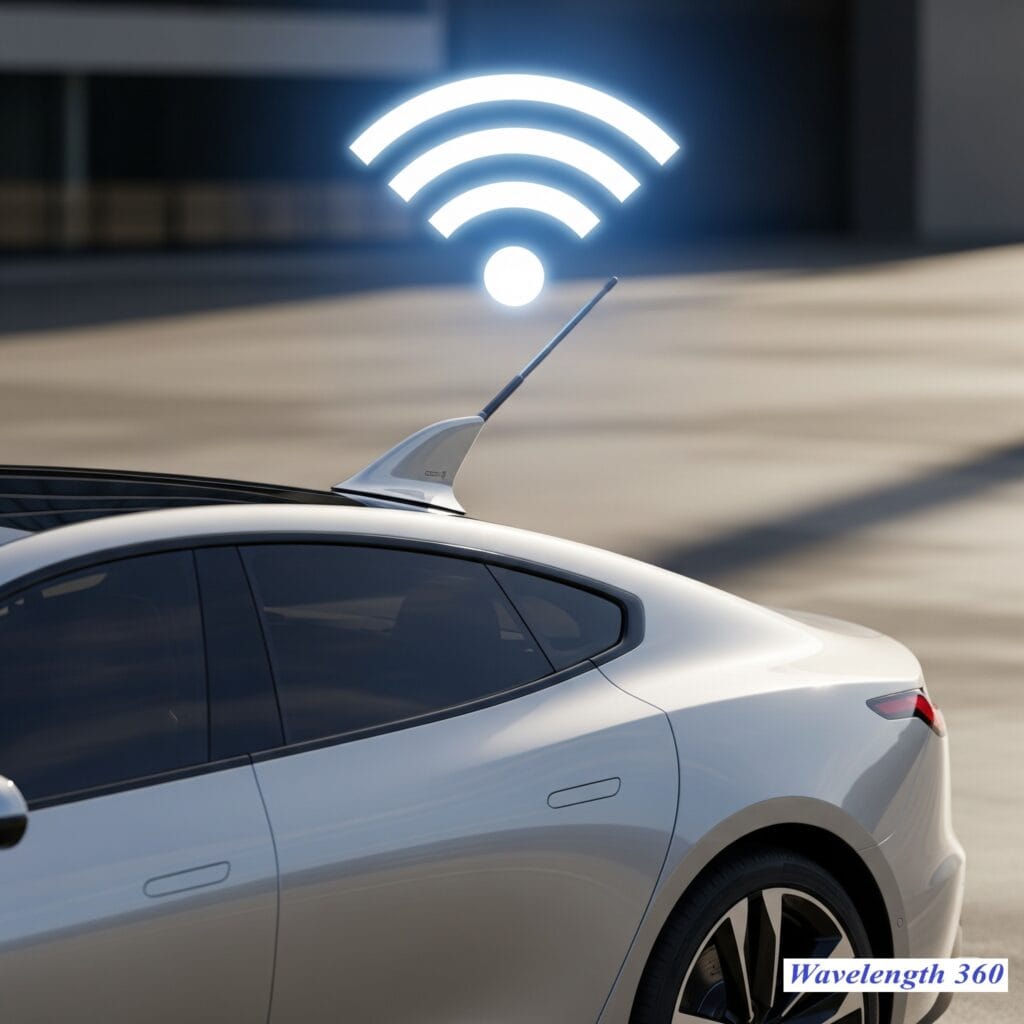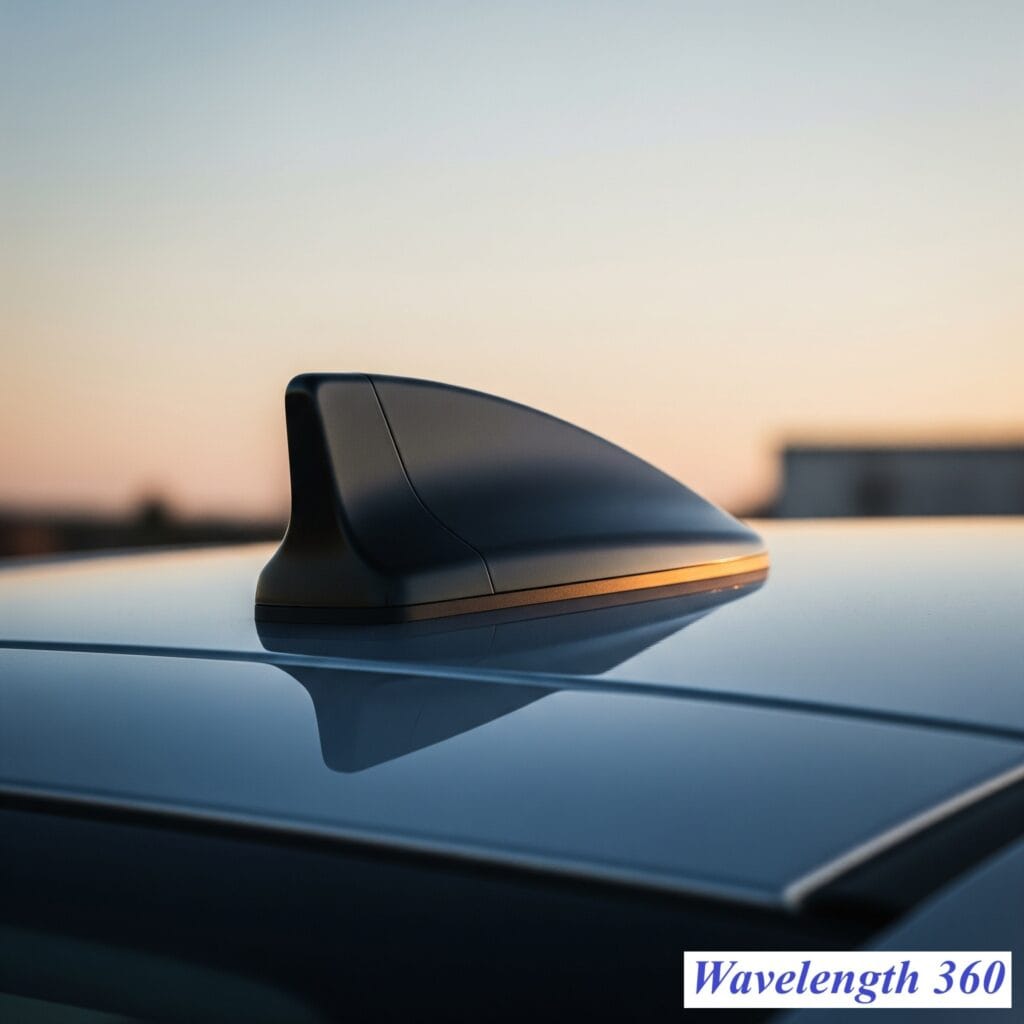Custom Antennas for Automotive & EV
Advanced Antenna Design Solutions for Stable Wireless Connectivity in Automotive & Electric Vehicles

Request Your Custom Antenna for Electric Vehicles and Cars
An antenna engineer will contact you with a free consultation and detailed guidance.
Why Automotive Connectivity Demands Precision Antenna Design
Today’s vehicles are more than mechanical machines — they’re intelligent, always-connected platforms. From electric vehicles to autonomous fleets, cars now rely on complex wireless systems to deliver performance, safety, convenience, and user experience. Antennas play a foundational role in enabling these systems to function reliably in dynamic, real-world driving environments.
Real-Time Communication is Now Core to Driving.
Automotive wireless systems handle far more than infotainment. They support:
- Vehicle-to-Cloud (V2C) data for diagnostics, OTA updates, and navigation
- Vehicle-to-Vehicle (V2V) and Vehicle-to-Infrastructure (V2X) communication for emerging ADAS and autonomous driving technologies
- GNSS navigation for precision routing and fleet coordination
- Mobile broadband (LTE and 5G) for streaming, telematics, and app integration
- In-cabin Wi-Fi and Bluetooth for seamless user connectivity
- Keyless entry, remote unlocking, and EV charging systems
Each of these functions depends on antennas that are tuned, isolated, and optimized to work in concert — without interference or dropouts.
The Automotive Environment Is Unforgiving
Antennas in vehicles are exposed to conditions that few other devices must endure. These include:
- Constant vibration and mechanical stress
- Extreme temperature changes, from sub-zero to high-heat environments
- Electromagnetic interference from high-current electrical systems, EV batteries, and inverters
- Metal-rich surroundings (frames, panels, chassis) that can detune antenna performance
- Glass coatings or plastics that alter signal propagation
Generic antenna modules often fail to deliver consistent performance under these conditions. A precision design — one that’s tailored for the materials, layout, and motion of a specific vehicle — ensures that signals stay stable, fast, and reliable even under stress.

Seamless Integration Is Critical to Form and Function
In automotive design, an antenna must not only work — it must fit into the vehicle’s body, style, and user interface. Whether it’s hidden inside a rear bumper, embedded into windshield glass, or integrated into a shark-fin module, antennas need to conform to the vehicle’s physical design without compromising signal quality.
This demands:
- Careful coordination with industrial designers and mechanical engineers
- Consideration of aesthetic impact, aerodynamic drag, and ease of assembly
- Support for multi-function antennas (e.g., LTE + GNSS + DAB + Wi-Fi) within compact housings
Without a precision antenna design process, these goals are often at odds — performance suffers to meet form, or the opposite.

Bottom Line: Vehicles Depend on Custom Connectivity
Every new generation of vehicles — especially EVs — requires more wireless bandwidth, more connected features, and higher integration between systems. Off-the-shelf antennas cannot account for the complex internal layout, electrical noise, and mechanical constraints of real-world vehicles.
What Type of Antenna Works Best in Cars and EVs?
Automotive antennas must do far more than just connect. They need to operate reliably in harsh environments, support multiple wireless technologies simultaneously, and often fit within compact or visually integrated housings. The best antenna for a vehicle depends entirely on where it’s placed, what it connects to, and how it fits into the vehicle’s architecture — electrically, mechanically, and stylistically.
Here’s how antenna types are typically selected for different use cases within cars and electric vehicles:
🔹 Roof-Mounted Modules (Shark Fin Antennas)
These are the most versatile and widely used antennas in modern cars. Housed in a low-profile aerodynamic enclosure, they often combine multiple antennas into a single unit:
- GNSS (GPS, GLONASS, Galileo)
- LTE or 5G cellular
- AM/FM/DAB radio
- Wi-Fi and Bluetooth
They are positioned at the highest point of the vehicle for maximum visibility and reduced body interference, which makes them ideal for global navigation, over-the-air updates, vehicle tracking, and streaming applications.
Custom design is key here — combining all these radios without crosstalk or detuning requires careful layout, isolation, and filtering.

🔹 Glass-Embedded Antennas
Many vehicles now incorporate antennas directly into the windshield, rear window, or side glass. These are often used for:
- AM/FM or DAB reception
- LTE or Wi-Fi connectivity
- GNSS fallback signals
These antennas remain hidden from view, offering a clean design. However, glass material, coatings (like UV or heating films), and curvature can impact antenna efficiency. That’s why tuning and placement are critical — and why custom glass-embedded antennas need to be designed for the specific make and model of the vehicle.
🔹 Bumper, Pillar, and Side-Mirror Antennas
For specific functions like keyless entry, tire pressure monitoring (TPMS), V2V/V2X communication, or low-speed radar, antennas are often placed in lower or side-facing vehicle components, such as:
- Rear bumpers
- C-pillars
- Side mirrors
- Underbody panels
These antennas are typically compact and rugged, and often directional. Since they’re closer to road noise, moisture, and impact zones, durability, waterproofing, and EMI immunity become just as important as RF performance.
🔹 In-Cabin Antennas
Inside the vehicle, you’ll find antennas for:
- Wi-Fi hotspots and mobile broadband sharing
- Bluetooth pairing with phones and media systems
- Wireless charging or Apple CarPlay/Android Auto connections
These are often integrated into the dashboard, center console, or headliner. Their design must ensure reliable short-range performance despite close proximity to other electronics, interior materials, and passenger movement. Custom antennas here focus on directional pattern control and resilience to near-field coupling.
Choosing the Right Antenna: It Depends on the System, the Signal, and the Space
There’s no universal “best” antenna for automotive systems — only the best antenna for your particular vehicle platform and wireless function. Each type has trade-offs in gain, isolation, location, and size. What matters most is how the antenna:
- Matches the radio’s frequency bands and use case
- Performs under real-world installation conditions
- Integrates cleanly into the car’s form without compromising function
At Wavelength 360, we build antennas around your product — not the other way around. From shark-fin combos to stealth glass designs and rugged sensor modules, our custom antennas are engineered for vehicle-grade reliability and production-ready integration.
Challenges in Automotive & EV Antenna Design
Creating antennas for vehicles and electric platforms is one of the most demanding areas of RF engineering. Unlike stationary or indoor systems, automotive environments introduce constantly changing RF conditions, tight mechanical constraints, and intense reliability requirements. Getting it right requires more than tuning for frequency — it takes a holistic understanding of the vehicle system, its environment, and its motion.
Below are the core challenges we solve when developing custom antennas for automotive and EV applications.
1. Multi-Band, Multi-Function Integration
Modern vehicles don’t use one antenna — they often use 6, 8, or more, sometimes within a single module. A typical shark-fin housing may need to support:
- Cellular (LTE, 5G sub-6 GHz)
- GNSS (GPS, Galileo, GLONASS)
- AM/FM or DAB radio
- Wi-Fi and Bluetooth
- V2X communications
Each function operates on different bands, with different power and isolation needs. Fitting all of these into a single compact structure without signal degradation or cross-interference is a complex design puzzle — one that generic antennas are not built to solve.
2. Metal-Rich and Electromagnetically Active Environments
Vehicles are full of metal — chassis, panels, reinforcements — and that metal affects every antenna’s near field. Even more, modern EVs introduce high-frequency switching electronics, motor inverters, and battery management systems that emit significant EMI (electromagnetic interference).
Antennas must be designed to:
- Avoid detuning from proximity to conductive structures
- Resist interference from on-board systems
- Preserve gain and pattern shape even when partially enclosed by vehicle bodywork
This requires precision placement, shielding techniques, and layout strategies tailored to the specific vehicle.
3. Harsh Physical Conditions
Antennas in cars aren’t gently handled. They face:
- Constant vibration
- Wide temperature swings, from sub-zero cold starts to intense summer heat
- Moisture, salt, dust, and UV exposure
- Repeated thermal cycling from engine or battery systems
That’s why materials, adhesives, enclosures, and PCB stackups must be automotive-grade — not just functionally correct, but proven to survive in the long term. Design choices must consider AEC-Q and ISO standards, especially for EVs where safety-critical systems depend on connectivity.
4. Aesthetic and Mechanical Constraints
Automotive designers demand sleek, aerodynamic shapes. That means antennas must:
- Hide inside rearview mirrors, rooflines, glass, bumpers, or dashboards
- Avoid disrupting the vehicle’s appearance
- Coexist with mechanical components, lighting systems, and HVAC parts
This leaves very little room — both physically and electromagnetically — for antennas to work properly. Simulated co-design between mechanical and RF teams becomes essential, allowing performance tuning to happen before parts are even prototyped.
5. Certification and OEM Validation
Antennas used in vehicles must comply with:
- Regional telecom regulations (FCC, CE, etc.)
- Automotive RF performance tests
- SAR (Specific Absorption Rate) limits
- Vehicle OEM validation and integration testing
Off-the-shelf antennas may not meet these criteria — especially when installed in custom enclosures or near complex vehicle systems. Custom design ensures the final implementation meets all requirements without compromising system performance.
Our Custom Antenna Capabilities for Automotive & EV
At Wavelength 360, we don’t just design antennas — we create custom RF solutions built for the evolving demands of modern vehicles and electric platforms. Whether you need a precision-tuned multi-band antenna inside a shark fin module or a rugged low-profile antenna integrated into a bumper or mirror, we build designs that are reliable, road-ready, and tailored to your platform.
Designed Around the Vehicle — Not Just the Specs
Generic antenna modules often underperform in automotive environments because they ignore the real-world variables that matter: metal proximity, internal EMI, mounting surfaces, and environmental stress. That’s why we develop each antenna with a full-system understanding, optimizing for how it behaves in your actual mechanical layout — not just in theory.
Our design process considers:
- Exact placement and enclosure materials (e.g., glass, plastic, metal)
- Proximity effects from EV motors, batteries, or infotainment systems
- Multi-antenna coexistence, tuned for isolation and minimal interference
- Automotive-grade thermal and mechanical tolerances
- Pre-certification readiness for OEM validation and compliance
What We Build
We design custom antennas for virtually every automotive and EV communication need, including:
- Multi-band shark fin modules (LTE, 5G, GNSS, Wi-Fi, AM/FM/DAB)
- Embedded antennas for glass, mirrors, bumpers, and dashboards
- Low-profile antennas for vehicle exteriors and sensor integration
- Combo and hybrid antennas (e.g., LTE + GNSS + Wi-Fi in one assembly)
- Directional or omnidirectional in-cabin antennas
- V2X and telematics antennas for real-time vehicle communication
- Custom internal PCB/FPC antennas for infotainment or access systems
Each antenna is custom-matched to your enclosure design and frequency needs, ensuring peak performance across all required bands without introducing internal EMI issues.
Our Approach to Automotive-Grade Design
Our design methodology ensures every solution is optimized for the automotive lifecycle:
1- Requirement Discovery
We gather critical inputs: target frequencies, placement constraints, target vehicles, materials, and mechanical drawings.
2- Simulation & Co-Design
We model antenna behavior within your actual CAD geometry, including interaction with nearby structures, RF noise sources, and thermal zones.
3- Prototype & Validation Support
We assist in antenna fabrication, placement validation, and lab testing. We also provide tuning support based on real-world test data.
4- Production-Ready Handoff
We deliver finalized antenna designs with manufacturing drawings, integration guidelines, and testing documentation aligned with OEM or tier-1 requirements.
Built to Your Platform — and to Last
Whether you’re working on a new EV platform, retrofitting connected services into an existing vehicle line, or developing smart charging infrastructure, we design antennas that deliver consistent, high-performance wireless communication under automotive conditions.
Our goal is simple: antennas that don’t just pass your tests — they thrive in them.
